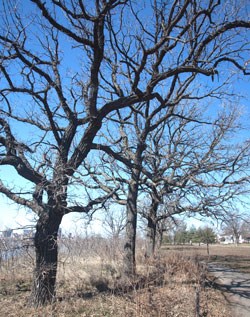
NPS/Gordon Dietzman IntroductionThis is the tree that is most associated with the savannas of our area. The thick, corky bark of mature trees insulated the living tissues within from the grass fires that frequently swept the savanna. For further protection from fire the bur oak leafs out fairly late--usually after the spring fire season--compared to other trees, thus protecting vulnerable leaves from heat and smoke damage. Other tree species, being less well adapted to fire, are often excluded from fire dominated ecosystems such as grasslands. These “open-grown” bur oaks may grow 50-80 feet tall and have thick trunks with widely-spreading, often crooked branches. The acorn is large and has a “burry” cap, from which this oak gets its name. The leaf has rounded tips on its lobes, but with a deeply incised “waist,” a characteristic it doesn’t share with other oaks in our area. The bark is gray and deeply furrowed in older trees. Twigs are both thick and blunt compared to many other trees. Fascinating Facts
Find ItBur oaks may be found on the bluff tops of Crosby Farm and Indian Mounds Regional Parks. A beautiful stand of bur oaks graces the lawns of the Highway 10 rest stop northwest of Anoka. Want to Help Us Better Understand the Park?See our iNaturalist project, "The Life of the Mississippi National River and Recreation Area" and contribute to it by downloading the iNaturalist app and uploading your sightings of this species, and others, to the project. You can also upload your sightings from your computer. |
Last updated: February 16, 2023
